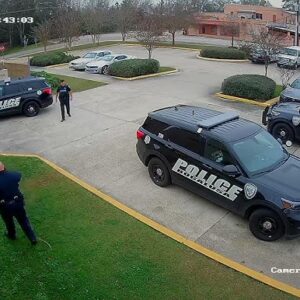The United States military has moved into a heightened state of alert off the coast of Venezuela, launching one of the most significant U.S. force deployments to the Caribbean in years. The scale of the operation signals a dramatic escalation in Washington’s pressure campaign against the Maduro regime.
The buildup includes four full squadrons of F/A-18 Super Hornets, now positioned within striking distance of Venezuelan airspace. U.S. Navy officials say these aircraft are cycling through near-constant patrols and readiness drills as the situation evolves.
Several U.S. warships have also taken up strategic positions in the region — vessels equipped with over 200 Tomahawk cruise missiles, giving the Pentagon enormous long-range precision-strike capability. The concentration of naval power represents roughly one-quarter of the entire deployed U.S. fleet, a level unseen in the Caribbean in modern times.
Reporter Lucas Tomlinson confirms that U.S. bombers, Marine expeditionary units, guided-missile destroyers, and cruisers are all now operating in theater. Senior defense officials say the buildup is linked to new efforts by the Trump Administration targeting narco-terror networks allegedly tied to Venezuelan leader Nicolás Maduro.
President Trump said he remains open to holding a direct conversation with Maduro “soon,” signaling that the White House is pairing military pressure with a possible diplomatic opening. Maduro, speaking to crowds in Caracas, insisted he wants “dialogue, not conflict,” even as his government faces terror designations, sanctions, and mounting global isolation.
Meanwhile, tensions increased further when a Russian-flagged oil tanker en route to Venezuela was intercepted by the USS Stockdale. The Pentagon described the encounter as “professional,” though the timing underscores the geopolitical stakes now unfolding around the country.
On the aviation front, the FAA has issued fresh warnings to commercial airliners flying near or over Venezuelan airspace, citing an increasingly unpredictable security environment. Airlines have been encouraged to reroute, and several have already done so.
Additionally, F/A-18s from the USS Gerald R. Ford have been spotted conducting visible offshore patrols, signaling to both allies and adversaries that U.S. airpower remains fully active and ready in the skies over the Caribbean.
Defense analysts say the scale and speed of this mobilization mark a major strategic moment in the Western Hemisphere. The military posture suggests the U.S. is prepared for a range of contingencies — from interdiction operations to potential strikes — depending on how events unfold.
As the deployment continues, global attention is now fixed on Caracas. The world is watching to see whether Maduro seeks negotiation, escalation, or something far more unpredictable in the days ahead.




